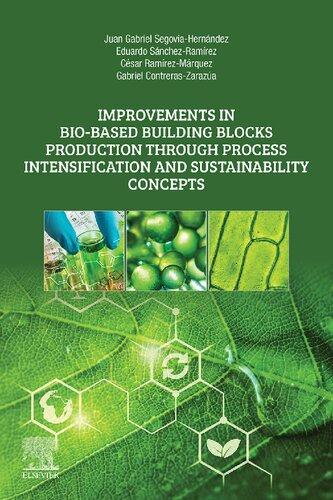Improvementsin Bio-BasedBuilding BlocksProduction ThroughProcess Intensificationand SustainabilityConcepts
JUANGABRIELSEGOVIA-HERNÁNDEZ
DepartmentofChemicalEngineering,Universityof Guanajuato,Guanajuato,Mexico
EDUARDOSÁNCHEZ-RAMÍREZ
DepartmentofChemicalEngineering,Universityof Guanajuato,Guanajuato,Mexico
CÉSARRAMÍREZ-MÁRQUEZ
DepartmentofChemicalEngineering,Universityof Guanajuato,Guanajuato,Mexico
GABRIELCONTRERAS-ZARAZÚA
DepartmentofChemicalEngineering,Universityof Guanajuato,Guanajuato,Mexico
Elsevier
Radarweg29,POBox211,1000AEAmsterdam,Netherlands TheBoulevard,LangfordLane,Kidlington,OxfordOX51GB,UnitedKingdom 50HampshireStreet,5thFloor,Cambridge,MA02139,UnitedStates
Copyright©2022ElsevierInc.Allrightsreserved.
Nopartofthispublicationmaybereproducedortransmittedinanyformorbyanymeans, electronicormechanical,includingphotocopying,recording,oranyinformationstorageand retrievalsystem,withoutpermissioninwritingfromthepublisher.Detailsonhowtoseek permission,furtherinformationaboutthePublisher’spermissionspoliciesandour arrangementswithorganizationssuchastheCopyrightClearanceCenterandtheCopyright LicensingAgency,canbefoundatourwebsite: www.elsevier.com/permissions
Thisbookandtheindividualcontributionscontainedinitareprotectedundercopyrightby thePublisher(otherthanasmaybenotedherein).
Notices
Knowledgeandbestpracticeinthisfieldareconstantlychanging.Asnewresearchand experiencebroadenourunderstanding,changesinresearchmethods,professionalpractices, ormedicaltreatmentmaybecomenecessary.
Practitionersandresearchersmustalwaysrelyontheirownexperienceandknowledgein evaluatingandusinganyinformation,methods,compounds,orexperimentsdescribed herein.Inusingsuchinformationormethodstheyshouldbemindfuloftheirownsafety andthesafetyofothers,includingpartiesforwhomtheyhaveaprofessionalresponsibility.
Tothefullestextentofthelaw,neitherthePublishernortheauthors,contributors,or editors,assumeanyliabilityforanyinjuryand/ordamagetopersonsorpropertyasamatter ofproductsliability,negligenceorotherwise,orfromanyuseoroperationofanymethods, products,instructions,orideascontainedinthematerialherein.
BritishLibraryCataloguing-in-PublicationData
AcataloguerecordforthisbookisavailablefromtheBritishLibrary LibraryofCongressCataloging-in-PublicationData
AcatalogrecordforthisbookisavailablefromtheLibraryofCongress ISBN:978-0-323-89870-6
ForInformationonallElsevierpublications visitourwebsiteat https://www.elsevier.com/books-and-journals
Publisher: SusanDennis
AcquisitionsEditor: AnitaKoch
EditorialProjectManager: AndreaR.Dulberger
ProductionProjectManager: BharatwajVaratharajan
CoverDesigner: ChristianJ.Bilbow
TypesetbyMPSLimited,Chennai,India
Contents
Authorbiographiesix
1.Whyarebio-basedchemicalbuildingblocksneeded?1
1.1 Arebio-basedchemicalbuildingblocksneeded?1
1.1.1 Drop-inbio-basedchemicals5
1.1.2 Novelbio-basedchemicals5
1.1.3 C6andC6/C5Sugar8
1.1.4 Plant-basedoil9
1.1.5 Algaeoil10
1.1.6 Organicsolutions10
1.1.7 Lignin11
1.1.8 Pyrolysisoil12 References13
2.Processintensificationandsustainability15
2.1 Processintensificationandsustainabilityinbioblocks15 References23
3.Basicconceptsonsimulationof(bio)chemicalprocesses25
3.1 (Bio)chemicalprocesses25
3.2 Conceptofsimulationinbioprocesses(chemical)25
3.2.1 Simulationcategoriesforbiochemicalprocesses26
3.2.2 Processsimulationbiochemicalapplications28
3.3 Conceptofmodelingandtoolsinprocessbiochemicals31
3.4 Theroleofsimulationandprocessmodelingbiochemicals31
3.5 Theroleofprocessoptimizationbiochemicals32 References32
4.Bioethanol33
4.1 Bioethanol33
4.2 Petrochemicalrouteofethanolproduction34
4.2.1 Process,rawmaterial,andkinetics34
4.2.2 Performanceindexintheproductionofethanolthrough petrochemical36
4.2.3 Disadvantagesintheproductionofethanolthroughpetrochemical37
4.3 Conventionalbioethanolproductionprocess37
4.3.1 Rawmaterialfortheproductionofbioethanol37
4.3.2 Productionofbioethanolfromlignocellulosicbiomass39
4.3.3 Advantagesanddisadvantagesofbioethanolproduction44
4.4 Problemsoftheprocessforobtainingconventionalbioethanol46
4.5 Proposalstointensifytheprocessforobtainingbioethanol46
4.5.1 Synthesis47
4.5.2 Design50
4.5.3 Control54
4.6 Conclusions58 References58
5.Biobutanol61
5.1 Generalcharacteristics,uses,andapplications61
5.2 Productionofbutanolfromfossilsources64
5.3 Butanolproductionbythebiochemicalroute66
5.3.1 Metabolicpathwayofacetone-butanol-ethanolfermentation66
5.3.2 Conventionalrawmaterialtoproducebutanol67
5.3.3 Isopropanol-butanol-ethanolfermentation71
5.4 Processintensificationappliedtobutanolproduction72
5.4.1 Processintensificationinthereactivezone73
5.4.2 Processintensificationinthedownstreamprocess79
5.5 Controllabilitystudiesappliedtointensifiedalternativesforbiobutanol purification87
5.6 Conclusions89 References89
6.Furfural95
6.1 Introduction95
6.2 Usesoffurfural96
6.3 Currentfurfuralmarkets98
6.4 Stoichiometricandkineticsmodelsforfurfuralproduction100
6.5 Currenttechnologiesforfurfuralproduction102
6.6 Newintensifiedproposesforfurfuralproduction106
6.6.1 Advancesinfurfuralpurification106
6.6.2 Objectivefunctions110
6.6.3 Optimizationresults114
6.6.4 Advancesinfurfuralpurificationusinghybridextractive distillationschemes117
6.7 Conclusions121 References123
7.Levulinicacid127
7.1 Introduction127
7.2 Currentusesoflevulinicacid129
7.3 Currentlevulinicacidmarkets130
7.4 Kineticsmodelsforlevulinicacidproduction132
7.5 Currentforlevulinicacidproduction133
7.6 Newintensifiedproposalsforlevulinicacidproduction137
7.7 Conclusions144 References144
8.Ethyllevulinate147
8.1 Introduction147
8.2 Currentapplicationsandmarketsofethyllevulinate148
8.3 Kineticsmodelsforethyllevulinateproduction149
8.4 Currenttechnologiesforethyllevulinateproduction150
8.5 Currentadvancesinethyllevulinateproduction152
8.6 Conclusions155 References156
9.2,3-Butanediol157
9.1 Introduction157
9.2 Productionof2,3-BDfromfossilandrenewablesources160
9.2.1 Microorganismsusefulintheproductionof2,3-BD162
9.3 Rawmaterialfor2,3-BDproduction165
9.3.1 Nonrenewablerawmaterials166
9.3.2 Renewablerawmaterials168
9.4 Processintensification(PI)in2,3-BDproduction169
9.5 PIin2,3-BDrecovery170
9.6 Conclusions175 References175
10.Methylethylketone181
10.1 Introduction181
10.2 MEKproduction184
10.2.1 MEKproductionfromnonrenewablesources184
10.2.2 MEKproductionfromrenewablesources185
10.2.3 Productionokmethylethylketonethroughprocessintensified schemes188
10.3 PurificationofMEKthroughintensifiedprocess195
10.4 Conclusionandfutureinsights200 References200
11.Lacticacid203
11.1 Lacticacid203
11.1.1 Usesoflacticacid204
11.1.2 Marketanddemandforlacticacid205
11.2 Chemicalrouteoflacticacidproduction206
11.2.1 Process,rawmaterial,andreactions206
11.2.2 Performanceindexinlacticacidproductionviapetrochemical207
11.2.3 Disadvantagesintheproductionoflacticacidvia petrochemical207
11.3 Conventionalprocessofproductionoflacticacidviafermentation ofbiomass208
11.3.1 Rawmaterialfortheproductionoflacticacidviabiomass209
11.3.2 Lacticacidproductionviabiomass209
11.3.3 Advantagesanddisadvantagesoflacticacidproductionvia biomass212
11.3.4 Problemsintheproductionoflacticacidviabiomass212
11.4 Proposalsforintensificationoftheprocessofobtaininglacticacidvia biomass212
11.4.1 Synthesisanddesign213
11.4.2 Optimization216
11.5 Conclusions224 References224
12.Futureinsightsinbio-basedchemicalbuildingblocks227
12.1 Futureinsightsinbio-basedchemicalbuildingblocks227 References231
Index 233
Authorbiographies
JuanGabrielSegovia-Hernández,Professorin theDepartmentofChemicalEngineeringof UniversityofGuanajuato(México),hasexpertisein thesynthesis,design,andoptimizationofbioprocesses.Hehascontributedtodefiningsystematic methodologiestofound,inacompleteway,optimumsustainableandgreenprocessesfortheproductionofseveralcommodities.Healsoappliedhis methodologiestotheproductionofbiofuelsand biobasedbuildingblocks.Productsofhisresearcharemorethan140papers publishedinhigh-impact-factorindexedjournals,3bookswithprestigious internationalpublishers,and4patentregisters.Inaddition,heactsasa reviewerformorethan25topjournalsinchemicalengineering,energy, andappliedchemistry.Forhispioneeringworkandremarkableachievementsinhisareaofscientificresearch,hewaselectedNationalPresidentof theMexicanAcademyofChemicalEngineering(2013 15)andhasbeena memberoftheMexicanAcademyofSciencessince2012.Healsoisthe AssociateEditorof ChemicalEngineeringandProcessing:ProcessIntensification JournalandChemicalEngineeringResearchandDesignJournal (Elsevier).


EduardoSánchez-Ramírez,Professoratthe DepartmentofChemicalEngineeringatthe UniversityofGuanajuato(Mexico)since2017,has gainedconsiderableexperienceintheareaofsynthesis,design,simulation,control,andoptimization ofchemicalprocesses.Currentlypublishedcontributionsfocusontheproductionofbiofuelsand basechemicalsinthechemicalindustry.Hehas currentlypublishedmorethan35articlesin indexedjournals,9bookchapterswithrenowned publishers,andhasregistered2patents.Heactsasareviewerofindexed journalsintheareaofenergyandchemicalengineering.Heearnedhis PhDsummacumlaudein2017andhisNationalSystemofResearchers Level1,SNIMexicoin2019.HewasGuestEditorof Chemical EngineeringandProcessingProcessIntensificationJournal inMay2020.

CésarRamírez-Márquez,ResearchAssociatein theChemicalEngineeringDepartmentofthe UniversityofGuanajuato,Mexico,holdsanMEng andaPhDfromtheUniversityofGuanajuato, Mexico,underthesupervisionofProf.J.G. Segovia-Hernández.Hisresearchfocusesonsynthesis,design,simulation,optimization,andcontrolof chemicalprocesses.Currentlypublishedcontributionsfocusontheproductionofmaterialsforthe solarenergyindustryandbasechemicalsinthe chemicalindustry.Hehascurrentlypublishedmorethan25journal papers,4bookchaptersandpresentedworkatmorethan10international/regionalconferences,andregisteredfourpatents.

GabrielContreras-Zarazúa,Professorinthe DepartmentofChemicalEngineeringatthe UniversityofGuanajuato,Mexico,since2017, obtainedhisPhDdegreeattheUniversityof Guanajuato,Mexico.HeobtainedhisPhDdegree summacumlaudein2020.Hisresearchisfocused ondesign,simulation,andoptimizationofbiorefineriestoproducehigh-valueproducts. Additionally,hehasexperienceincontrolanalysis, lifecycleandsafetyassessments,anddesignand optimizationofsupplychainsappliedtobioprocesses.Currently,hehas publishedmorethan15articlesinindexedjournals,2bookchapters,and hasregistered1patent.Heisareviewerofindexedjournalsintheareas ofchemicalengineeringandprocessintensification. x Authorbiographies
Whyarebio-basedchemical buildingblocksneeded?
Contents
1.1 Arebio-basedchemicalbuildingblocksneeded?1
1.1.1 Drop-inbio-basedchemicals5
1.1.2 Novelbio-basedchemicals5 1.1.3 C6andC6/C5Sugar8
1.1.4 Plant-basedoil9
1.1.5 Algaeoil10
1.1.6 Organicsolutions10
1.1.7 Lignin11
1.1.8 Pyrolysisoil12
References13
1.1Arebio-basedchemicalbuildingblocksneeded?
Continuous,inspiring,andinterconnectedstep-by-stepchangesin thoughtandunderstanding,know-how,actions,andbehaviorhaveoften beeninstrumentalintransitionsfromoneparticularagetothenext inhumanhistory.Thisalsoappliestothepresentcenturyanditssustainabilitychallengesattheplanetary,regional,andlocallevels.Therefore,it isofgreatimportanceandrelevancetomoveforwardonthejourneythat hasbeenstartedgloballytoaddressanotinsignificantnumberofchallenges.Itis,however,essentialtogobeyonddescriptiveworkbycontinuingwithnovel,inspiring,andinterconnectedstepstofindsolutionsto overcomethesechallenges.Asthishugetaskalsorequiresmultidimensionalcommunication,understanding,andactionsacrossdifferentregions, cultures,disciplines,andknowledgeareas,thedevelopmentofacommon conceptualframeworksuchastheconceptofbioeconomyhasbeen acceptedgloballyasveryvaluable(Sierraetal.,2021).
ThegeneralorientationprovidedbytheUnitedNationsSustainable DevelopmentGoals(SDGs)isofspecialinterestandacalltoactionforall stakeholderstoreachtheSDGsby2030.Throughouthistory,finding
innovativesolutionsbasedonavailablebiologicalresourcestosuccessfully overcomechallengeshasbeenahallmarkofhumanachievements. Therefore,theaccumulatedtraditionalknowledgeandskillsandtherapid advancesinthelifescienceshavemadebiotechnologyakeyenabling technologytowardimprovingthequalityoflife.Bioeconomy,bringing togetherbioresources,biotechnology,ecosystems,andeconomy,has emergedasanattractivetop-levelpoliticalconceptforcreating,developing,andrevitalizingeconomicsystemsworldwidebymakinguseof renewablebiologicalresourcesinasustainableway.Asthereisnouniversaldefinition,weareverymuchinlinewiththeoneadoptedbythe GlobalBioeconomySummitin2015,whichdefinedbioeconomyas “the knowledge-basedproductionandutilizationofbiologicalresources,innovativebiologicalprocessesandprinciplestosustainablyprovidegoodsand servicesacrossalleconomicsectors” (Wohlgemuthetal.,2021).
Theevolutionfrompoliticalobjectivesofabioeconomythatisbased onknowledgeintherelevantsciencesandtechnologies,industries,and societiestobioeconomypolicies,strategies,andinitiativeshasbeen spreadingrapidlyworldwide.Biotechnologyisakeyenablingtechnology, notonlyforhighlydevelopedanddiversifiedbioeconomiesbutalsofor advancedandbasicprimarysectorbioeconomies.Fromthegivendefinition,itisobviousthatbioeconomyismuchmorethanbiotechnologyand includesothersciences,butitalsogoesbeyondinnovationsinsciences andtechnologiesbyincorporatingindustrial,organizational,political,and socialinnovations.
Animportantaspectofbioeconomyisnotonlytocollectandsummarizeexistingknowledgebutalsotopresentandevaluatenewstrategies andtechnologicalprocesses,andtosuggestandtoselectthebestdirectionsofchangeanddevelopment,takingintoaccountglobal,regional, andlocalspecificities.Resourcedistributionandallocation,increasingspecialization,andfacilitatedtransportationandtradeworldwidehaveshown thestrengthsofexchangingandsharingproductsandprovidedtremendousopportunitiesforeconomicgrowth.Aswellasstrengths,these developmentshavealsodemonstratedimbalances,weaknesses,andthreats toglobalsupplychains.Aholisticandinnovativebioeconomyapproach takesintoaccountvariousperspectivesacrossdifferentdisciplinesofscience,industry,andsocietytomakescience-basedpoliticaldecisionsand createsustainablenewopportunitiesandvaluecreationchains.Largeeconomicvalueiscreatedfrombiotransformationsofbio-basedandfossilbasedresourcestointermediariesandfinalproducts,whichenterthe
3 Whyarebio-basedchemicalbuildingblocksneeded?
industrialmanufacturingchaintowardassuitablegoods.Thisvaluecreationarisesinmanyareassuchashealth,nutrition,materials,energy,and environmentinevermorecomplexanddiversifiedbioeconomynetworks.Bio-basedindustriesisakeyenablingtechnologyinallofthese bioeconomynetworks(Sierraetal.,2021).
Bioprocessesarosefromthefieldofzymotechnology,whichbeganas asearchforabetterunderstandingofindustrialfermentation,particularly inrelationtothebrewingofbeer.Beerwasanimportantindustrial,and notjustsocial,commodity.Inlate-19thcenturyGermany,brewingcontributedasmuchtothegrossnationalproductasdidsteel,andtaxeson alcoholprovedtobesignificantsourcesofrevenue.Inthe1860s,institutesandremunerativeconsultancieswerededicatedtothetechnologyof brewing.ThemostfamouswastheprivateCarlsbergInstitute,foundedin 1875,whichemployedEmilChristianHansen,whopioneeredthepure yeastprocessforthereliableproductionofconsistentbeer.Lesswell knownwereprivateconsultanciesthatadvisedthebrewingindustry.One ofthese,theZymotechnicInstitute,wasestablishedinChicagobythe German-bornchemistJohnEwaldSiebel.
TheexpansionofzymotechnologycontinuedduringWorldWarIin responsetoindustrialneedstosupportthewar.MaxDelbrückgrewyeast onanimmensescaleduringthewartomeet60%ofGermany’sanimalfeed needs.Compoundsofanotherfermentationproduct,lacticacid,madeup foralackofhydraulicfluid,glycerol.OntheAlliedside,theRussianchemistChaimWeizmannusedstarchtoeliminateBritain’sshortageofacetone,a keyrawmaterialforcordite,byfermentingmaizetoacetone.Theindustrial potentialoffermentationoutgrew itstraditionalhomeinbrewing,and zymotechnologysoongavewayto “biotechnology” (Doran,2012).
Withfoodshortagesspreadingandresourcesfading,somedreamedof anewindustrialsolution.TheHungarianKárolyErekycoinedtheword “biotechnology” inHungaryin1919todescribeatechnologybasedon convertingrawmaterialsintoamoreusefulproduct.Hebuiltaslaughterhousefor1000pigsandalsoafatteningfarmwithspacefor50,000pigs, andheraisedover100,000pigsayear.Theenterprisewasenormous, becomingoneofthelargestandmostprofitablemeatandfatoperations intheworld.Inhisbook, Biotechnologie,Erekyfurtherdevelopedatheme thatwouldbereiteratedthroughthe20thcentury:biotechnologycould providesolutionstosocietalcrises,suchasfoodandenergyshortages.For Ereky,theterm “biotechnology” indicatedtheprocessbywhichraw materialscouldbebiologicallyupgradedintosociallyusefulproducts.
ThiscatchwordspreadquicklyafterWorldWarI,astheword “biotechnology” enteredGermandictionariesandwastakenupabroadby business-hungryprivateconsultanciesasfarawayastheUnitedStates.In Chicago,forexample,thecomingofprohibitionattheendofWorldWar Iencouragedbiologicalindustriestocreateopportunitiesfornewfermentationproducts,inparticularamarketfornonalcoholicdrinks.EmilSiebel, thesonofthefounderoftheZymotechnicInstitute,brokeawayfromhis father’scompanytoestablishthe “BureauofBiotechnology,” whichspecificallyofferedexpertiseinfermentednonalcoholicdrinks.
Thebeliefthattheneedsofanindustrialsocietycouldbemetbyfermentingagriculturalwastewasanimportantingredientofthe “chemurgic movement.” Fermentation-basedprocessesgeneratedproductsofevergrowingutility.However,thisflourishingindustryoffermentationto obtainbioproductsbegantocompeteeconomicallywiththeadvantages ofobtainingthesameproductsfromnonrenewablesources(oil)inamore efficientwayandatalowercost(Doran,2012).
Inrecentyears,duetothelargeincreaseinpetroleumcost,therehas beenareemergenceofinterestinlarge-volumeproductionoffermentationchemicals.Biotechnologyisprovidingnew,low-cost,andhighlyefficientfermentationprocessesfortheproductionofchemicalsfrombiomass resources.Moreover,withawiderangeofmicroorganismsalreadyavailableandmuchmorerecentlydiscovered,thefermentationofsugars representsanimportantroutefortheproductionofnewbioproducts. However,thecurrenteconomicimpactoffermentationbioproductsis stilllimited,inlargepartaresultofdifficultiesinproductrecovery.Thus, substantialimprovementstoexistingrecoverytechnologyareneededin ordertoallowchemicalsfromfermentationtopenetratefurtherinthe organicchemicalindustry(Cormaetal.,2007).
Thebio-basedindustryisanemergingsectororganizedaroundinterconnectedvaluechains,whichaimstotransformrenewablebiological feedstock,suchasforestry,agricultural,andaquaticbiomass,aswellas sidestreamsandbyproductsfromindustrialbioprocessing,andotherresiduessuchassludgeandmunicipalwaste,intobio-basedproducts,materials,fuels,andenergy,replacingtheirfossil-basedcounterparts.Theyoffer ahugepotentialtotacklesocietalandenvironmentalchallengesand,additionally,playanimportantroleinstimulatingsustainablegrowthand boostingthecompetitivenessofcountriesbyreindustrializingandrevitalizingruralandcoastalareasandprovidingnewjobopportunities.
5 Whyarebio-basedchemicalbuildingblocksneeded?
Therealitythatcanbeseeninthesebio-basedprojectsisthatnew valuechainsaremuchmoreinterconnected.Thesevaluechainsarise fromtheconnectionsbetweendifferenttypesoffeedstockanddifferent processingandbiorefiningtechnologies,transformingthemintoawide varietyofbio-basedchemicalbuildingblocks(CBBs),materials,foodand feedingredients,andconsumerproducts(e.g.,cosmetics)forawiderange ofmarketsectors,therebyproducinganever-increasingnumberofnew bio-basedvaluechains.Thisalsocorrespondstotherealityofthebiobasedsectordevelopment;hencetherelevanceofCBBsintheconceptof bioeconomy.
ACBBisamoleculethatcanbeconvertedtovarioussecondarychemicalsandintermediates,and,inturn,intoabroadrangeofdifferent downstreamuses.Thelargestmarketsforbio-basedCBBsareintheproductionofbio-basedpolymers,lubricants,andsolvents.Thischapterlooks attwotypesofbio-basedCBBs:drop-inbio-basedchemicalsandnovel bio-basedchemicals(UnitedStatesDepartmentofEnergyEnergy EfficiencyandRenewableEnergy,2004).
1.1.1Drop-inbio-basedchemicals
Drop-inchemicalsarebio-basedversionsofexistingpetrochemicalsthat haveestablishedmarkets.Astheyarechemicallyidenticaltoexisting hydrocarbon-basedproducts,theirusecanreducefinancialandtechnologicalrisksandpromotefasteraccesstomarketsforproducers.
1.1.2Novelbio-basedchemicals
Novelbio-basedchemicalsbearhigherfinancialandtechnologicalrisks forproducersbutcanbeusedtoproduceproductssuchasaconicacid andmethylenesuccinicacidthatcannotbeobtainedthroughtraditional chemicalreactionsandproductsthatmayofferuniqueandsuperiorpropertiesthatareunattainablewithfossil-basedalternatives,suchas biodegradability.
ThereisanexistingmarketforCBBs,butitcanbeconsideredrelativelyimmature,withdevelopmentlevelsvaryingaccordingtothebuildingblockconsideredandrangingfromproofofconceptinthelaboratory tofullcommercialproduction.Strongcooperationwithinthevaluechain fromfeedstockproducertoenduserisrequiredfornewCBBstosuccessfullyenterthemarket.
In2013,thedemandforbio-basedCBBsinEuropewas1029 MEUR,equivalentto35%ofthetotalglobalproduction.Themarket grewatacompoundannualgrowthrateofapproximately18.6%per annumbetween2008and2015.Ithasbeenestimatedthatby2030the bio-basedCBBsmarketinEuropecouldreachbetween4.8and 10.4BEUR.Themarketvaluecouldbegreaterthanthisifthevarious hurdlestothedevelopmentofbio-basedCBBsareaddressed.Thegreatest driverforthemarketuptakeofbio-basedCBBsistoovercomeincreasing volatilityinfossil-fuelpriceandsupply.Marketpricesforchemicalsrise whenfossilsupplyistight,sothesubsequentincreasinguncertaintyand volatilityofcrudeoilpricesislikelytopushcommoditychemicalcompaniestowardbringinginalternativestotraditionalfossilfuelstoensurethat theircustomershaveastableproductsupply.
Oneofthekeyhurdlestotheproductionofbio-basedCBBsisthat offeedstockavailabilityandcost.MostofthecurrentlyavailablebiobasedCBBsarebasedoncommodityagriculturalproductssuchassugars andvegetableoilswhichcanvarysignificantlyinpriceandareexpensive.GiventhatmanyCBBsarebulkch emicals,alargeamountoffeedstockwillbeneeded.Thereareconcernsbysomethatthepotential forsupplyingextrasugarandoilsislimited,thoughothersbelievethat thereisstillmuchpotentialforyieldimprovementinsuchcommodities. Theuseofwasteandresiduestream swouldbeattractiveastheyare bothcheapandwidelyavailable.Thea bilitytointercha ngefeedstocks accordingtoavailabilitywouldalsobe useful.Manytechnicalchallenges, especiallyrelatingtodownstreamprocessingneedtobeovercometo helppromotetheuseofalternativefe edstockstreamsandreduceprocessingcosts,butevenifthesechallenges aresuccessfullyaddressed,itwill benecessarytopersuadehighlyconservativeprocessorstochangethe productionprocesstoaccommodateanewfeedstockoraproduct withnewproperties.Acombinationofhighfeedstock,conversionand downstreamprocessingcostsmeanth atthecostofproducingbio-based chemicalsiscurrentlymoreexpensivethanprocessesusingfossil-fuel feedstocks.Opportunitiesforbio-basedpremiumstoovercomeprice differentialsforCBBsareconsideredtobelowerthanforothermarkets, forinstancebioplastics,becauseth eCBBproducerisfurtherawayfrom thefinalconsumer.
Thegreatesthurdletopromotinginvestmentsinbio-basedchemicals howeverisregulatoryuncertaintyandinstabilitythroughitseffectson pricinganddemandforproducts.Vaguenessintermssuch “waste” ,
Whyarebio-basedchemicalbuildingblocksneeded?
7
“residues”,and “ green ” failtoprovidesufficientinvestmentcertainty, whileatpresentincentivesforbioenergyandbiofuelmarketsmeanthat thesesectorscanpaymoreforfeedstockthannonincentivedmarketssuch asbio-basedchemicalsresultingfromfeedstockpricesthatareartificially inflated.
CurrentglobalCBB(excludingbiofuels)isestimatedtobearound 50milliontons.Notableexamplesofbio-basedchemicalsincludenonfoodstarch,cellulosefibers,andcellulosederivatives,talloils,fattyacids, andfermentationproductssuchasethanolandcitricacid.However,the majorityoforganicchemicalsandpolymersarestillderivedfromfossilbasedfeedstocks,predominantlyoilandgas.Nonenergyapplications accountforaround9%ofallfossil-fuel(oil,gas,andcoal)useand16%of oilproducts.Globalpetrochemicalproductionofchemicalsandpolymers isestimatedataround330milliontons.Theprimaryoutputisdominated byasmallnumberofkeybuildingblocks,namelymethanol,ethylene, propylene,butadiene,benzene,toluene,andxylene(UnitedStates DepartmentofEnergyEnergyEfficiencyandRenewableEnergy,2004). Thesebuildingblocksaremainlyconvertedtopolymersandplasticsbut theyarealsoconvertedtoastaggeringnumberofdifferentfineandspecialtychemicalswithspecificfunctionsandattributes.Fromatechnical pointofview,almostallindustrialmaterialsmadefromfossilresources couldbesubstitutedbytheirbio-basedcounterparts.However,thecost ofbio-basedproductioninmanycasesexceedsthecostofpetrochemical production.Also,newproductsmustbeproventoperformatleastas goodasthepetrochemicalequivalenttheyaresubstitutingandtohavea lowerenvironmentalimpact.
Historicallybio-basedchemicalproducershavetargetedhigh-value fineorspecialtychemicalsmarkets,oftenwherespecificfunctionality playedanimportantrole.Asproofoftheaforementioned Fig.1.1 shows someofthemostcommonsugarobtainedfrombiomassandtheirrespectivedownstreamprocessesusedtoproducehigh-valuecommodities. Currently,thelowpriceofcrudeoilactedasabarriertobio-basedcommoditychemicalproductionandproducersfocusedonthespecificattributesofbio-basedchemicalssuchastheircomplexstructuretojustify productioncosts.
Bio-basedCBBcanbeclassifiedbasedonanumberoftheirkeycharacteristics(InternationalEnergyAgency BioenergyReport,2007). Majorfeedstocksincludeperennialgrasses,starchcrops(e.g.,wheatand maize),sugarcrops(e.g.,beetandcane),lignocellulosiccrops(e.g.,
Figure1.1 Mainsugarsobtainedfrombiomassandtheirrespectivemaindownstreamprocesses.
managedforest,shortrotationcoppice,switchgrass),lignocellulosicresidues(e.g.,stoverandstraw),oilcrops(e.g.,palmandoilseedrape), aquaticbiomass(e.g.,algaeandseaweeds),andorganicresidues(e.g., industrial,commercial,andpost-consumerwaste).Thesefeedstocks includefive-andsix-carboncarbohydratesfromstarch,sucrose,orcellulose;amixedfive-andsix-carboncarbohydratesstreamderivedfrom hemicelluloses,lignin,oils(plant-basedoralgal),organicsolutionsfrom grasses,pyrolyticliquids.
1.1.3C6andC6/C5Sugar
Six-carbonsugarplatformscanbeaccessedfromsucroseorthroughthe hydrolysisofstarchorcellulosetogiveglucose.Glucoseservesasfeedstockfor(biological)fermentationpr ocessesprovidingaccesstoavariety ofimportantCBBs.GlucosecanalsobeconvertedbychemicalprocessingtousefulCBBs.Mixedsix-andfive-carbonplatformsareproduced fromthehydrolysisofhemicellulose s.Thefermentationofthesecarbohydratestreamscanintheoryproducethesameproductsassix-carbon sugarstreams;however,technical, biological,andeconomicbarriers needtobeovercomebeforetheseopportunitiescanbeexploited. Chemicalmanipulationofthesestreamscanprovidearangeofuseful molecules.
1.1.3.1Fermentationproducts
ThenumberofCBBsaccessiblethroughfermentationisconsiderable. Fermentationhasbeenusedextensivelybythechemicalindustryto
9 Whyarebio-basedchemicalbuildingblocksneeded?
produceseveralproductswithchemicalproductionthroughfermentation. Modernbiotechnologyisallowingtheindustrytotargetnewandpreviouslyabandonedfermentationproductsandimprovetheeconomicsof productswithcommercialpotential.Coupledwithincreasingfossilfeedstockcosts,costreductionsintheproductionoftraditionalfermentation products,suchasethanolandlacticacid,willallowderivativeproductsto captureneworincreasedmarketshares.Improvingcoststructureswill alsoallowpreviouslyabandonedproductssuchasbutanoltoreenterthe market.Manyseethefutureabundantavailabilityofcarbohydrates derivedfromlignocellulosicbiomassasthemaindriver.Fermentationalso givestheindustryaccesstonewCBBspreviouslyinaccessibleduetocost constraints.Thedevelopmentofcost-effectivefermentationprocessesto succinic,itaconic,andglutamicacidspromisesthepotentialfornovel chemicaldevelopment.
1.1.3.2Chemicaltransformationproducts
Six-andfive-carboncarbohydratescanundergoselectivedehydration, hydrogenation,andoxidationreactionstogiveusefulproducts,suchas: sorbitol,furfural,glucaricacid,hydroxymethylfurfural,andlevulinicacid (InternationalEnergyAgency BioenergyReport,2007).
1.1.4Plant-basedoil
Theoleochemicalindustryisamajorproducerofbio-basedproducts.The majorityoffattyacidderivativesareusedassurfaceactiveagentsinsoaps, detergents,andpersonalcareproducts.Majorsourcesfortheseapplications arecoconut,palmandpalmkerneloil,whicharerichinC12 C18saturatedandmonounsaturatedfattyacids.Importantproductsofunsaturated oils,suchas:soybean,sunflowerandlinseedoil,includealkydresins,linoleum,andepoxidizedoils.Rapeseedoil,highinoleicacid,isafavored sourceforbiolubricants.Commercializedbifunctionalbuildingblocksfor bio-basedplasticsincludesebacicacidand11-aminoundecanoicacid,both fromcastoroil,andazelaicacidderivedfromoleicacid.Dimerizedfatty acidsareprimarilyusedforpolyamideresinsandpolyamidehotmeltadhesives.Inapplicationssuchaslubricantsandhydraulicfluids,plantoilcanact asadirectreplacementformineral(petroleum-derived)oilorrequireonly minorchemicalmodification.Asachemicalfeedstock,thetriacylglycerol molecule themajorcomponentofmostplantoils iseither(1)cleavedto glycerolandfattyacidsor(2)convertedtoalkylestersandglycerolbytransesterification.Theutilityofthefattyacidsandestersisdeterminedprimarily
bytheirchainlengthandfunctionality.Givenadvancesinplantgenetics andoilprocessing,thereisconsiderableinterestindevelopingplantoilsfor themanufactureofpolymerssuchaspolyurethanes,polyamides,andepoxy resins.Thereisalsoanimportantsubcategoryofoilseedsthatproducenaturalwaxes,suchasliquidwaxfromjojobaseedsandsolidwaxescollected fromtheleafsurfacesoftheCarnubaPalmandseveraldesertshrubs.These tendtobeusedinspecializedhigh-valueapplications,suchascosmetics. Theirexcellentlubricityandstabilityinlubricantapplicationshaveledto interestinengineeringwaxesterproductionincommercialoilseedcrops (InternationalEnergyAgency BioenergyReport,2007).
1.1.5Algaeoil
Therearemorethan40,000differentalgaespeciesbothinseawaterand freshwater.Algaebiomasscanbeasustainablerenewableresourceforchemicalsandenergy.Themajoradvantagesofusingmicroalgaeasarenewableresourceare:
1. comparedtoplants,algaehavehigherproductivity;
2. microalgaecanbecultivatedinseawaterorbrackishwateronnonarable land;anddonotcompeteforresourceswithconventionalagriculture;
3. theessentialelementsforgrowtharesunlight,water,CO2,andinorganicnutrientssuchasnitrogenandphosphorouswhichcanbefound inresidualstreams;
4. thebiomasscanbeharvestedduringallseasonsandishomogenous andfreeoflignocellulose.
Themaincomponentsofmicroalgaearespeciesdependentbutcan containahighproteincontent,quantitiescanbeupto50%ofdryweight ingrowingcultureswithall20aminoacidspresent.Carbohydratesas storageproductsarealsopresentandsomespeciesarerichinstorageand functionallipids,theycanaccumulateupto50%lipids,andinveryspecific casesupto80%(thegreenalgae Botryococcus)accumulateslongchain hydrocarbons.Othervaluablecompoundsincludepigments,antioxidants, fattyacids,vitamins,antifungals,antimicrobials,antiviraltoxins,andsterols (InternationalEnergyAgency BioenergyReport,2007).
1.1.6Organicsolutions
Theorganicsolution(pressjuice)containsvaluablecompounds,suchas carbohydrates,proteins,freeaminoacids,organicacids,minerals,hormones,andenzymesdependingonwhetherthebiomassusedasthe
feedstockisfreshorsilage.Solublecarbohydratesandproteins main componentsoffreshplantjuice canbeusedasafermentationmedium orforgeneratingfeedproducts.Silagepressjuicehasbeendemonstrated asfeedstockfortheproductionofbiochemicalsandfuels.Theorganic solution(pressjuice)containsvaluablecompounds,suchascarbohydrates, proteins,freeaminoacids,organicacids,minerals,hormones,andenzymes dependingonwhetherthebiomassusedasthefeedstockisfreshorsilage.
Solublecarbohydratesandproteins maincomponentsoffreshplant juice canbeusedasfermentationmediumorforgeneratingfeedproducts.Silagepressjuicehasbeendemonstratedasfeedstockfortheproductionofbiochemicalsandfuels.Lacticacidanditsderivatives,aswellas proteins,aminoacids,bioethanols,andenergyviaanaerobicdigestion,are themostfavorableendproductsfromtheorganicsolutionplatform (InternationalEnergyAgency BioenergyReport,2007).
1.1.7Lignin
Ligninoffersasignificantopportunityforenhancingtheoperationofalignocellulosicbiorefinery.Itisanextremelyabundantrawmaterialcontributingasmuchas30%oftheweightand40%oftheenergycontentof lignocellulosicbiomass.Lignin’snativestructuresuggeststhatitcouldplaya centralroleasanewchemicalfeedstock,particularlyintheformationof supramolecularmaterialsandaromaticchemicals.Uptonow,thevast majorityofindustrialapplicationshavebeendevelopedforlignosulfonates. Thesesulfonatesareisolatedfromacidsulfitepulpingandareusedina widerangeoflowervalueapplicationswheretheformbutnotthequality isimportant.Around67.5%ofworldconsumptionoflignosulfonatesisfor dispersantapplicationsfollowedbybinderandadhesiveapplicationsat 32.5%.Majorend-usemarketsincludeconstruction,mining,animalfeeds, andagricultureuses.Theuseofligninforchemicalproductionhassofar beenlimitedduetocontaminationfromsalts,carbohydrates,particulates, volatiles,andthemolecularweightdistributionoflignosulfonates.Theonly industrialexceptionisthelimitedproductionofvanillinfromlignosulfonates.Inadditiontolignosulfonates,kraftligninisproducedasacommercialproductforuseasanexternalenergysourceandfortheproductionof value-addedapplications.Theproductionofmorevalue-addedchemicals fromlignin(e.g.,resins,compositesandpolymers,aromaticcompounds, andcarbonfibers)isviewedasamedium-tolong-termopportunitythat dependsonthequalityandfunctionalityoftheligninthatcanbeobtained (InternationalEnergyAgency BioenergyReport,2007). 11 Whyarebio-basedchemicalbuildingblocksneeded?
1.1.8Pyrolysisoil
Biomasspyrolysisisthethermaldepolymerizationofbiomassatmodest temperaturesintheabsenceofaddedoxygen.Thespectrumofproducts frombiomasspyrolysisdependsontheprocesstemperature,pressure,and residencetimeoftheliberatedpyrolysisvapors.Abiorefinerybasedon pyrolysisoilisdesignedmuchlikeatraditionalrefinery.Firstbiomassis convertedintopyrolysisoil,whichcanbeadecentralizedprocess. Second,pyrolysisoilfromdifferentinstallationsiscollectedatthebiorefinerywhereitwillbedividedintodifferentfractions.Eachfractioncan beupgradedwithadifferenttechnologytofinallyderivetheoptimal combinationofhigh-valueandlowvalueproductsfromthepyrolysisoil. Themajorhigh-valuecompoundswhichareforeseenarephenols, organicacids,furfural,Hidroximetilfurfural(HMF),andlevoglucosan. Themajoradvantagesofapyrolysistransformationisthepossibilityof decentralizedproductionoftheoilinregionswhereabundantbiomassis readilyavailable,makingitpossibletokeepthemineralsinthecountry oforiginandcreatingthepossibilit yofcost-effectivetransportofthe resultingliquids.Thebasisforcreatinghigh-valuecompoundsisthe cost-effectivefractionationofthepyrolysisoil.Fractionationwillresult invariousqualitiesofoilneededforfurtherupgradingintofinechemicals,petrochemicals,automotivefuelsandenergy(InternationalEnergy Agency BioenergyReport,2007 ).
In Fig.1.2,thegeneralclassificationofbio-basedCBBsisshownin summaryform.
Insummary,althoughmanychemicalsthatarecurrentlyproduced frompetroleumwilllikelybeproducedfrombiomassinthefuture, severalchallengesstillremaintoacceleratecommercialization.The developmentofahigh-performancestrainisstillthegreatestchallenge thatrequiresmuchtime,effort,andmoney.Systemsmetabolicengineeringandotheradvancedtoolsandstrategiesthathavebeencontinuouslydevelopedwillplayimportantrolesinmorerapidlyand inexpensivelydevelopingindustrialstrains.Economicalpreparationof fermentablesubstratesfromnonfoodbiomassremainstobeadvanced further.Insteadofutilizingfermentablecarbohydrates,theuseof wastebiomassandevencarbondioxidewillbemoreactivelypursued. Microbialfermentationmostlyrequireswater,andthustheuseand reusestrategyoffermentationwaterneedstobeactivelydeveloped.
Whyarebio-basedchemicalbuildingblocksneeded?
Figure1.2 Classificationofbio-basedchemicalbuildingblocks.
Althoughsuchchallengesstillremain,itisgreattoseetheenormous progressthathasbeenmadeinthebio-basedproductionofmanyofthe platformchemicals.Weareindeedmovingtowardabio-basedeconomy.
References
Corma,A.,Iborra,S.,Velty,A.,2007.Chemicalroutesforthetransformationofbiomass intochemicals.Chem.Rev.107,2411 2502.
Doran,P.,2012.BioprocessEngineeringPrinciples,2ndeditionAcademicPress. InternationalEnergyAgency,(2007),Bioenergyreporttask42:biorefinery,bio-basedchemicalsvalueaddedproductsfrombiorefineries.
Sierra,A.R.,Zika,E.,Lange,L.,deAzua,P.L.R.,Canalis,A.,Esteban,P.M.,etal.,2021. Thebio-basedindustriesjointundertaking:ahighimpactinitiativethatistransforming thebio-basedindustriesinEurope.NewBiotechnol.60,105 112. UnitedStatesDepartmentofEnergyEnergyEfficiencyandRenewableEnergy,(2004) Report:topvalueaddedchemicalsfrombiomass,volumei resultsofscreeningfor potentialcandidatesfromsugarsandsynthesisgas.
Wohlgemuth,R.,Twardowski,T.,Aguilar,A.,2021.Bioeconomymovingforwardstep bystep aglobaljourney.NewBiotechnol.61,22 28.
Thispageintentionallyleftblank



















